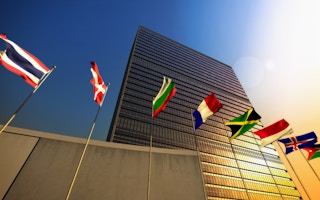On September 23, heads of state and leaders in finance, business and civil society will gather in New York City for the United Nations Climate Summit 2014. The summit is a critical milestone on the path to addressing the global threat of climate change. UN Secretary-General Ban Ki-moon organized the high-level meeting to re-engage world leaders to spur climate action on national and international stages.
To continue reading, subscribe to Eco‑Business.
There's something for everyone. We offer a range of subscription plans.
- Access our stories and receive our Insights Weekly newsletter with the free EB Member plan.
- Unlock unlimited access to our content and archive with EB Circle.
- Publish your content with EB Premium.
Tens of thousands of concerned citizens are seizing the opportunity, organizing the largest climate march in history. During summit week, hundreds of organizations have arranged speeches, documentary film showings, and other gatherings to present the overwhelming evidence of the consequences of climate change and cost-effective solutions to address the problem. New scientific research like the National Climate Assessment and the latest IPCC reports have illuminated the risks from carbon pollution, while new economic analysis including WRI’s upcoming New Climate Economy report will dispel the notion that climate action will slow economic growth.
Yet this is hardly the first time governments have convened to counter climate change. So why is this summit worth watching? Here’s why:
1) It’s the First Time In Five Years that Heads of State Have Gathered to Address Climate Change
This will be the first time in five years—since the 2009 negotiations in Copenhagen — that so many world leaders have gathered to discuss climate change. Secretary-General Ban established the summit to kick-start a 15-month period of intense climate engagement and negotiations to try to reach a global agreement in December 2015. Building momentum in New York City will be critically important to achieving that goal.
2) Obama and Xi Will Be There
Both U.S. President Barack Obama and Chinese President Xi Jinping, leaders of the world’s two largest emitting countries, will attend the summit. If substantive measures to address greenhouse gas emissions are to be achieved, both the United States and China will need to be integrally involved. Encouragingly, the two countries are already collaborating on clean energy projects at the research, business and government levels through initiatives like the US-China Clean Energy Research Center (CERC). In July they unveiled eight new climate partnership agreements. The presence of these respective heads of state at the summit offers another opportunity for continued cooperation.
3) New Voices Calling for Greater Action
Most of the current country leaders were not yet in power during the 2009 Copenhagen summit. Many of them are outspoken about the current threat climate change poses to their countries, as well as the prospect of economic opportunities from shifting to a low-carbon economy. These new voices come from middle-income countries such as Chile, Colombia, Costa Rica and Indonesia, where governments are implementing ambitious climate policies or have indicated their willingness to do so. Their new perspectives will shape these high-level discussions.
Poorer countries are also expected to come forward to present their challenges and their contributions to solving the problem.
4) New Commitments from Countries, Cities and the Private Sector
“
The summit will be a harbinger for the commitment of heads of state to tackle the climate crisis in the lead-up to Paris and beyond. Strong, clear commitments would elevate climate change on the global agenda and set the stage for national and international progress.
The one-day summit will be a forum for countries to share new initiatives. In fact, the whole morning is packed with three concurrent sessions where countries will announce their climate actions. The announcements will likely range from commitments to capitalize the Green Climate Fund, as Germany recently did by pledging $1 billion dollars to help countries prepare for climate impacts and pursue low-carbon pathways, to domestic actions that prompt a shift from coal and toward scaled-up renewables.
World leaders can also use the gathering to commit to present a draft of their post-2020 climate plans by March 2015 (known as “intended nationally determined contributions” or INDCs) – and will encourage their peers to do so as well. Abiding by this deadline will give domestic and international stakeholders an opportunity to respond and suggest improvements before countries submit their final proposals nine months later in Paris.
Finally, the gathering offers a platform for bold, new ideas from the private sector and city leaders. Expect to learn of brand new private- and/or public efforts on energy, low-carbon cities, forest restoration, transportation, agriculture, finance and resilience. These new initiatives will supplement country actions by engaging all levels of society in the global effort to tackle this problem.
5) The Global Transition to Clean Energy is Reshaping the Policy Landscape
The rapid adoption of renewable energy in recent years has shifted what was considered feasible just five years ago. Solar manufacturing costs have plummeted 80 percent and wind power has never been more affordable. Last October, Denmark produced more energy from wind power than the country consumed. China has set aggressive renewable energy targets for 2015, 2017 and 2020. More and more American utilities are finding that wind and solar offer the cheapest way to add additional generating capacity. And nearly 100 developing countries now have renewable energy policies in place. The shifting energy landscape and strong social and economic benefits from transitioning to clean energy enables world and corporate leaders to make a strong case for climate leadership.
A Chance for World Leaders to Commit to Climate Action
The summit will be a harbinger for the commitment of heads of state to tackle the climate crisis in the lead-up to Paris and beyond. Strong, clear commitments would elevate climate change on the global agenda and set the stage for national and international progress.
During a high-level meeting in Abu Dhabi this May, Secretary-General Ban urged participants to “empower and motivate your national leaders to bring bold announcements to the Climate Summit in September… The race is on. It’s time to lead.” In a few short weeks we will see if leaders are up to the challenge.
Jennifer Morgan is director, Climate and Energy Programs at the World Resources Institute. This post originally appeared on WRI’s Insights blog.











